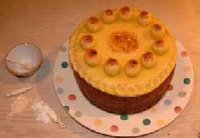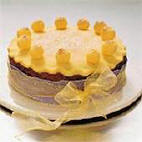:::::::::::::::::::::::::::::::::::::::::::::::::::::::::::::::::::::::::::::::::::::::::::::::::::::
Mothering Sunday, Laetare
***** Location: Ireland, Great Britain, Commonwealth
***** Season: Early spring (Northern Hemisphere),
........end of hot dry season (Kenya)
***** Category: Observance
*****************************
Explanation
Mothering Sunday
is an ancient church festival which, in some countries and in modern times, has become mixed up with the secular celebration of Mothers' Day. It is also in this modern day and age, that many women are not mothers, and that we have become more aware of the suffering of those who have wished to be mothers but could not, those who have lost their children and those who have lost their mothers, as well as those who cannot be with their mothers for one reason or another.
The church is therefore seeking its way back to the roots of the festival, the celebration of the mother church, bringing the opportunity to meet one's extended family on a day of pilgrimage and celebration.
The fourth Sunday in Lent is Laetare, also called Refreshment Sunday, the day when the Lenten fast is relaxed. For those in the Roman Catholic, Anglican or Lutheran traditions, the priests (including the Pope -- see the photos below) wear rose pink vestments, for one of only two occasions in the year (the other being Gaudete, the third Sunday of Advent).
Isabelle Prondzynski
xxxxxxxxxxxxxxxxxxxxxxxxxxxxx
Origins of Mothering Sunday
In this commercial age, it is easy to think that Mothers' Day is yet another excuse for the greetings card industry to extract our money.
However, unlike the festival on the second Sunday in May, created in America in 1914, our Mothers' Day or Mothering Sunday has been celebrated on the fourth Sunday in Lent since the early church. Centuries ago it was considered important for people to return to their home or 'mother' church once a year, which inevitably became an occasion for family reunions. It was this that led to the tradition of children, particularly those working as domestic servants or apprentices away from home, being given the day off to visit and take gifts to their mothers.
Mothering Sunday was also known as Refreshment Sunday, because the fasting rules for Lent were relaxed on tha day. A food item especially associated with the day is simnel cake: a rich fruit cake with almond paste on top and in the middle. For strict adherers to the Lenten fast, the cake had to keep until Easter Day, which is when it is now more commonly found on our tea tables.
http://parish.ashtead.org/east04/mother.htm
xxxxxxxxxxxxxxxxxxxxxxxxxxxxx

http://static.flickr.com/4/7596738_cd1c0bb37d.jpg?v=0
xxxxxxxxxxxxxxxxxxxxxxxxxxxxx
From a Mothering Sunday sermon
I managed to discover that in days gone by it was considered important for people to return to their home or "mother" church once a year. So each year in the middle of Lent, everyone would visit their "mother" church, or the main church or Cathedral of the area. Inevitably the return to the "mother" church became an occasion for family reunions when children who were working away returned home. (It was quite common in those days for children to leave home for work once they were ten years old.)
And most historians think that it was the return to the "Mother" church which led to the tradition of children, particularly those working as domestic servants, or as apprentices, being given the day off to visit their mother and family.
As they walked along the country lanes, children would pick wild flowers or violets to take to church or give to their mother as a small gift.
http://www.ascensionbalhamhill.org.uk/Resources/MotheringSunday.htm
xxxxxxxxxxxxxxxxxxxxxxxxxxxxx

http://www.themildredmittensmanufactory.co.uk/img176060.jpg
xxxxxxxxxxxxxxxxxxxxxxxxxxxxx
A Foodie Festival
Mothering Sunday was also known as Refreshment Sunday because the fasting rules for Lent were relaxed that day.
Originally both Old and New Testament lessons on mid-lent Sunday made a point of food.
The Gospel reading from the New Testament told the story of how Jesus fed five thousand people with only five small barley loaves and two small fish.
Now there was much grass in the place; so the men sat down, in number about five thousand. Jesus then took the loaves, and when he had given thanks, he distributed them to those who were seated; so also the fish, as much as they wanted. (John 6:10-12)
Simnel Cake
The food item specially associated with Mothering Sunday is the Simnel Cake.
A Simnel cake is a fruit cake with two layers of almond paste, one on top and one in the middle.
The cake is made with 11 balls of marzipan icing on top representing the 11 disciples. (Judas is not included.) Traditionally, sugar violets would also be added.
Why Simnel?
The name Simnel probably comes from the Latin word "simila" which means a fine wheat flour usually used for baking a cake.
There's a legend that a man called Simon and his wife Nell argued over whether the cake for Mothering Sunday should be baked or boiled. In the end they did both, so the cake was named after both of them: SIM-NELL.
http://www.bbc.co.uk/religion/religions/christianity/features/mday/mday2.shtml
xxxxxxxxxxxxxxxxxxxxxxxxxxxxx
More background, and a delicious Simnel cake recipe :
http://www.chippingnorton.net/Features/simnel%20cake.htm

http://www.chippingnorton.net/images/Simnel_Cake_2.jpg
http://www.chippingnorton.net/images/simnel.jpg
http://www.chippingnorton.net/images/simnel1.jpg
xxxxxxxxxxxxxxxxxxxxxxxxxxxxx
The Pope in Rose
AP - Sun Mar 26, 2006, 7:36 AM ET
Pope Benedict XVI waves to faithful prior to celebrating Mass during his visit to God Our Merciful Father Church on the outskirts of Rome, Sunday, March 26, 2006. The pontiff took inspiration from his predecessor Sunday, reading what he said was a message of love and hope that the late Pope John Paul II had intended to read the day after he died.
http://www.splendoroftruth.com/curtjester/archives/006622.php
More photos of the Pope :

(AP Photo/Plinio Lepri)
http://michaeldubruiel.blogspot.com/2006/03/pope-in-pink-rose-laetare-sunday.html
xxxxxxxxxxxxxxxxxxxxxxxxxxxxx
In some places, this Sunday is the only time during Lent in which Christian marriage may be solemnized. And let's not forget the rose vestments. Rose colored vestments apparently have two different explanations. The first is the that the color of rose comes from the floral gifts given to mothers on account of sons being able to see the mothers once again upon reunification with their families. The other more likely origin comes from the tradition of the Golden Rose.
On this fourth Sunday of Lent, the Pope would bless the "Golden Rose" to be sent to Catholic kings and queens. This Sunday became known as "Dominca de Rosa," and eventually rose colored vestments were introduced to complement the theme.
http://www.freerepublic.com/focus/f-religion/1603625/posts
*****************************
Worldwide use
Germany
In Germany, Laetare is the Sunday when the Lenten fast is relaxed and the priests wear rose coloured vestments -- but there is no link with a celebration of motherhood :
Freudensonntag Laetare
Mitten in der Passionszeit, besser: in der „Fastenzeit", gibt es paradoxerweise ein Fest der Freude: Dieser vierte Sonntag nach Aschermittwoch (in diesem Jahr am 25. März) heißt lateinisch „Laetare", nach dem Anfangswort des liturgischen Gesangs „Freuet euch mit Jerusalem" aus dem biblischen Buch Jesaja.
Freude mitten in der Fastenzeit?
Das erklärt sich so: Traditionell ist die Fastenzeit von Zurückgezogenheit und Buße geprägt. Der Sonntag Laetare ermuntert die Christen dazu, sich auf den Palmsonntag zu freuen, der den Einzug Jesu in die Heilige Stadt zum Thema hat. Wenn sich an Laetare auch die Leidensgeschichte Jesu ankündigt, ist doch die Freude über die bevorstehende Erlösung der Menschen groß. Katholische und evangelische Geistliche dürfen im Gottesdienst eine ungewöhnliche Gewandfarbe tragen: Rosa. Während in der Passionszeit insgesamt die Farbe Violett vorgeschrieben ist, also die Farbe der Buße und Besinnung, symbolisiert das Rosa eine Erleichterung der Bußpraxis.
http://www.chrismon.de/cservice/clex_f-j.html
:::::::::::::::::::::::::::::::::::::::::::::::::::::::::::::::::::::::::::::::::::::::::::::::::::::::
Ireland
Mothering Sunday in Ireland is particularly associated with daffodils, which may be distributed to the women in the congregation during or after the Church Service. Mothering Sunday coincides with the day when the secular Mothers' Day is celebrated.
Kenya
In Kenya too, Mothering Sunday and Mothers' Day coincides, without, however, being a major festival or a commercial occasion beyond the major cities.
Isabelle Prondzynski.
*****************************
Things found on the way
Half way through Lent (on Laetare Sunday), La Louvière in Belgium wakes up with the sound of the drum roll and the Gilles' clogs clanking. Coming from a 150 year old tradition, the Carnival of Laetare takes place in the "Cité des Loups" (Wolves city, nickname of La Louvière) and brings along three days of intense entertainment around a warm and friendly folklore.
Lots of pictures, with carnival music :
http://www.laetare.be/index_uk.htm
*****************************
HAIKU
staying at home
but with thoughts in the church --
mothering sunday
Isabelle Prondzynski
xxxxxxxxxxxxxxxxxxxxxxxxxxxxx
roses in her name
to climb out of our reach
Mothering Sunday
http://www.poetrymagazines.org.uk/magazine/record.asp?id=10506
xxxxxxxxxxxxxxxxxxxxxxxxxxxxx
Laetare Sunday!
Champagne on the table,
The Anglican Way.
Bill Snyder
http://rathernot.classicalanglican.net/index.php?p=20
almost mother's day
my best daffodils bent low
in the constant rain
Paul Conneally
Loughborough UK
:::::::::::::::::::::::::::::::::::::::::::::::::::::::::::::::::::::::::::::::::::::::::::::::::::::::
Laetare Sunday . . .
waking to the sound
of lawn mowers
Elaine Andre
March 2013
*****************************
Related words
***** Mother's Day
Good page, with a link to Mothers' Days around the world :
http://www.woodlands-junior.kent.sch.uk/customs/easter/mothers.htm
***** Lent
:::::::::::::::::::::::::::::::::::::::::::::::::::::::::::::::::::::::::::::::::::::::::::::::::::::
. Christian Celebrations in Japanese Kigo
[ . BACK to WORLDKIGO TOP . ]
:::::::::::::::::::::::::::::::::::::::::::::::::::::::::::::::::::::::::::::::::::::::::::::::::::::





No comments:
Post a Comment